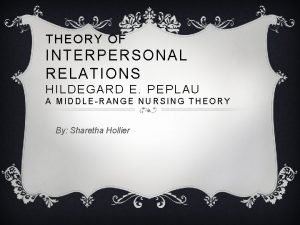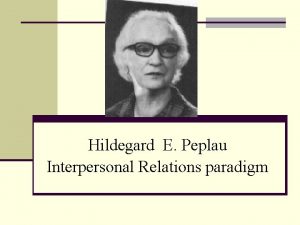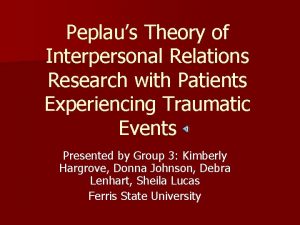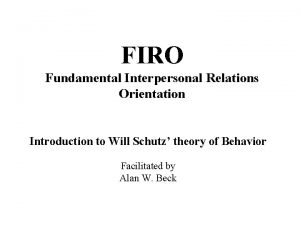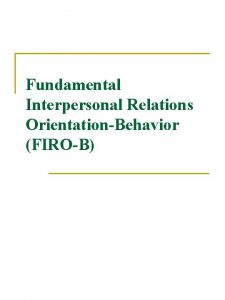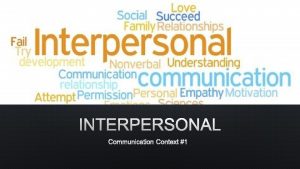THEORY OF INTERPERSONAL RELATIONS AND THE TIDAL MODEL









- Slides: 9

THEORY OF INTERPERSONAL RELATIONS AND THE TIDAL MODEL Ho-Sup Kim Athabasca University Click on audio icons

HILDEGARD PEPLAU Hildegard Peplau graduated from Pottstown (Pennsylvania) Hospital Training school in 1931. Finished undergraduate Studies in 1938 at Bennington College (Vermont), masters studies from Columbia University in 1947 then became Professor Emeritus from Rutgers University (D’Antonio, Beeber, Sills & Naegle, 2013). Wrote Interpersonal Relations in Nursing: Offering a Conceptual Frame of Reference for Psychodynamic Nursing in 1952 (D’Antonio, Beeber, Sills & Naegle, 2013). Started the first post baccalaureate program in nursing (D’Antonio, Beeber, Sills & Naegle, 2013). Produced work on psychodynamic nursing theory. Died in Figure 1: Hildegard Peplau (Forchuk, n. d. ) 1999 (D’Antonio, Beeber, Sills & Naegle, 2013).

THEORY OF INTERPERSONAL RELATIONS Stage One: Orientation Stage Two: 2. 1: Identification 2. 2: Exploitation Stage Three: Termination Figure 2: Nurse patient relationship (Nursing Theories, n. d. )

PHIL BARKER AND POPPY BUCHANAN-BARKER Phil Barker works as psychotherapist and have been teaching and supervising nurses on psychotherapy since the 1980’s (The Tidal Model, 2015). Poppy Buchanan-Barker is a social worker working with young people affected by physical and mental disabilities (The Tidal Model, 2015). Figure 3: Phil Barker and Poppy Buchanan. Barker (Tidal: Recovery and Reclaimation, 2015) The Tidal Model was developed from the Newcastle University 5 -year study of the need for nursing to have a substantive theory on mental health care (Barker, 2001).

TIDAL MODEL 1. Value the voice 2. Respect the language 3. Develop genuine curiosity 4. Become the apprentice 5. Reveal personal wisdom 6. Be transparent 7. Use the available toolkit 8. Craft the step beyond 9. Give the gift of time 10. Know that change is Wikipedia contributors. “Tidal Model. " Wikipedia, The Free constant Encyclopedia. Wikipedia, The Free Encyclopedia, 16 Oct. 2019. Web. 4 Nov. 2019. Figure 4: Tidal Wave (BHA, 2018)

TIDAL MODEL SOSU Fyn (2014, May 8). The Tidal Model – by Dr. Phil Barker [Video file]. https: //www. youtube. com/watch? v=Soy. YS 7 oqg 0 Y

CASE STUDY A 26 year-old man is brought to an emergency department by police after a violent altercation. He is in handcuffs with minor lacerations to the face. Respiratory rate is high and his face appears flushed. He is verbally aggressive and makes dismissive comments towards hospital staff. He refuses to remain seated and stands in a corner. The man yells out that he hates the hospital and demands to be released.

STRENGTHS AND LIMITATIONS Theory of Interpersonal Relations - Sequential and systematic approach, easily replicable. - Fits well with established nursing conventions. - System relies on nursing assessment (observation), power dynamics still favour the healthcare provider. The Tidal Model - Open-ended, broad commitments and competencies allow interactions to be adaptable. - Takes a stronger stance at establishing egalitarian relationships between healthcare provider and patient - An intuitive philosophical approach. - Lacks quantitate support. Savaşan and Cam (2017) conducted a randomized controlled trial. Found Tidal Model had no statistical significance.

REFERENCES Barker P. (2001). The Tidal Model: developing a person-centered approach to psychiatric and mental health nursing. Perspectives in Psychiatric Care, 37(3), 79– 87. Retrieved from http: //0 search. ebscohost. com. aupac. lib. athabascau. ca/login. aspx? direct=true&db=rzh&AN=106928809&site=edslivev=Soy. YS 7 oqg 0 Y Barker, P. (2014, May 8). The Tidal Model – by Dr. Phil Barker [Video file]. Retrieved from https: //www. youtube. com/watch? v=Soy. YS 7 oqg 0 Y D’Antonio, P. , Beeber, L. , Sills, G. , & Naegleline. (2014). The future in the past: Hildegard Peplau and interpersonal relations in nursing. Nursing Inquiry, (4), 311. https: //0 -doi-org. aupac. lib. athabascau. ca/10. 1111/nin. 12056 Savaşan, A. , & Çam, O. (2017). The Effect of the Psychiatric Nursing Approach Based on the. Tidal Model on Coping and Self-esteem in People with Alcohol Dependency: A Randomized Trial. Archives of Psychiatric Nursing (3), 31. Retrieved from https: //0 -www-sciencedirect-com. aupac. lib. athabascau. ca/science/article/pii/S 0883941716301169? via%3 Dihub Senn, J. F. (2013). Peplau’s Theory of Interpersonal Relations: Application in Emergency and Rural Nursing Science Quarterly, 26(1), 31– 35. https: //0 -doi-org. aupac. lib. athabascau. ca/10. 1177/0894318412466744 SOSU Fyn (2014, May 8). The Tidal Model – by Dr. Phil Barker [Video file]. https: //www. youtube. com/watch? v=Soy. YS 7 oqg 0 Y The Tidal Model (2015). Tidal: Recovery and Reclaimation - history. Retrieved from http: //www. tidalmodel. com/history. htm Wikipedia contributors. “Tidal Model. " Wikipedia, The Free Encyclopedia, 16 Oct. 2019. Web. 4 Nov. 2019.
 Interpersonal relations theory by hildegard peplau
Interpersonal relations theory by hildegard peplau Hildegard peplau referat
Hildegard peplau referat Theory of interpersonal relations
Theory of interpersonal relations Nclarity
Nclarity Peplau model
Peplau model Firo theory
Firo theory Fundamental interpersonal relations orientation-behavior
Fundamental interpersonal relations orientation-behavior Employee relations in public relations
Employee relations in public relations Single basin and double basin tidal power plant
Single basin and double basin tidal power plant Advantages of tidal energy
Advantages of tidal energy
